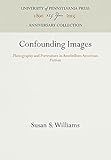Confounding Images : Photography and Portraiture in Antebellum American Fiction / Susan S. Williams.
Material type: TextPublisher: Philadelphia : University of Pennsylvania Press, [2016]Copyright date: ©1997Edition: Reprint 2016Description: 1 online resource (246 p.) : 27 illusContent type:
TextPublisher: Philadelphia : University of Pennsylvania Press, [2016]Copyright date: ©1997Edition: Reprint 2016Description: 1 online resource (246 p.) : 27 illusContent type: - 9780812233971
- 9781512808872
- American fiction -- 19th century -- History and criticism
- Art and literature -- United States -- History -- 19th century
- Ekphrasis
- Literature and photography -- United States -- History -- 19th century
- Portrait photography -- United States -- History -- 19th century
- LITERARY CRITICISM / American / General
- 813 21
- PS374.P43
- online - DeGruyter
| Item type | Current library | Call number | URL | Status | Notes | Barcode | |
|---|---|---|---|---|---|---|---|
 eBook
eBook
|
Biblioteca "Angelicum" Pont. Univ. S.Tommaso d'Aquino Nuvola online | online - DeGruyter (Browse shelf(Opens below)) | Online access | Not for loan (Accesso limitato) | Accesso per gli utenti autorizzati / Access for authorized users | (dgr)9781512808872 |
Browsing Biblioteca "Angelicum" Pont. Univ. S.Tommaso d'Aquino shelves, Shelving location: Nuvola online Close shelf browser (Hides shelf browser)

|

|

|

|

|

|

|
||
| online - DeGruyter The Love of Krishna : The Krsnakarnamrta of Lilasuka Bilvamangala / | online - DeGruyter Imageless Truths : Shelley's Poetic Fictions / | online - DeGruyter Unwording the World : Sameil Beckett's Prose Works After the Nobel Prize / | online - DeGruyter Confounding Images : Photography and Portraiture in Antebellum American Fiction / | online - DeGruyter Dickens and the Short Story / | online - DeGruyter NLRB Regulation of Election Conduct : A Study of the National Labor Relations Board’s Policies and Standards for Setting Aside Representation Elections Based on Postelection Objections / | online - DeGruyter Four Cities : A Study in Comparative Policy Making / |
Frontmatter -- Contents -- List of Illustrations -- Preface -- Introduction: Confounding Images -- 1. The Portrait and the Social Construction of Ekphrasis -- 2. "The Inconstant Daguerreotype": The Narrative of Early Photography -- 3. The Haunted Portrait and Models of Authorship in Periodicals and Gift Books -- 4. Hawthorne, Daguerreotypy, and The House of the Seven Gables -- 5. Melville's Pierre and the Burden of Imitation -- 6. The Photography of Travel: Reading The Marble Faun -- Afterword: Photography and Portraiture in the Later Nineteenth Century -- Notes -- Bibliography -- Index
restricted access online access with authorization star
http://purl.org/coar/access_right/c_16ec
Susan Williams recovers the literary and cultural significance of early photography in an important rereading of American fiction in the decades preceding the Civil War. The rise of photography occurred simultaneously with the rapid expansion of magazine publication in America, and Williams analyzes the particular role that periodicals such as Godey's Lady's Book, Burton's Gentleman's Magazine, and Atkinson's Casket played in defining how photography was received. At the center of the book are readings of a stunning array of fiction by forgotten and canonical writers alike, including Edgar Allan Poe, Louisa May Alcott, and Sarah Hale, as well as extended interpretations of Nathaniel Hawthorne's House of the Seven Gables and The Marble Faun and Herman Melville's Pierre. In a concluding section, Williams offers a view of the fictional portrait in the later nineteenth century, when the proliferation of illustrated books once again transformed the relation between word and image in American culture.
Mode of access: Internet via World Wide Web.
In English.
Description based on online resource; title from PDF title page (publisher's Web site, viewed 23. Jul 2020)


